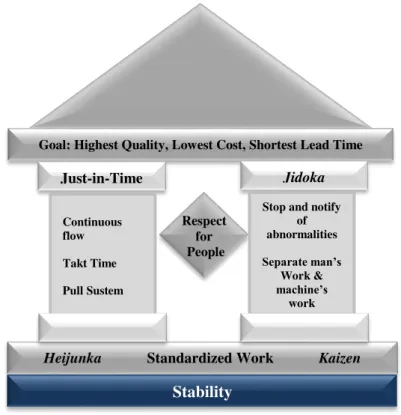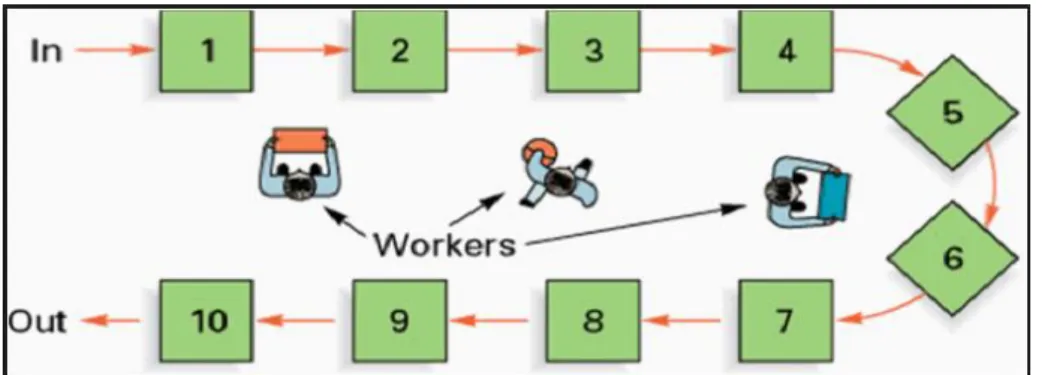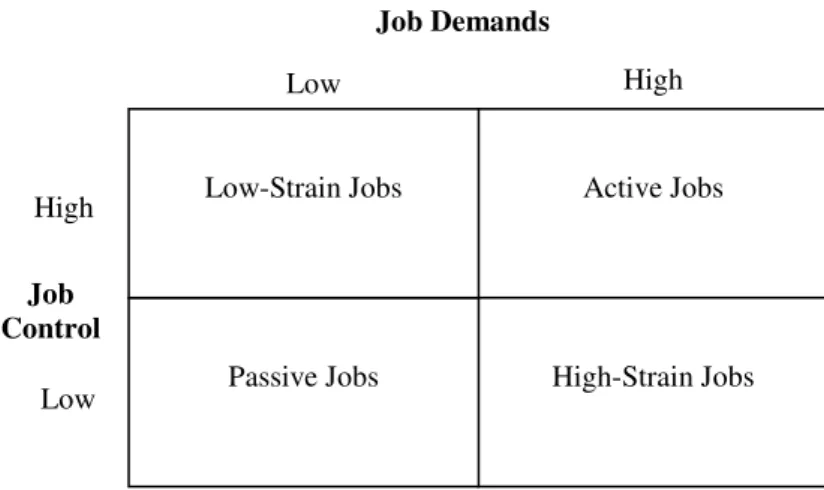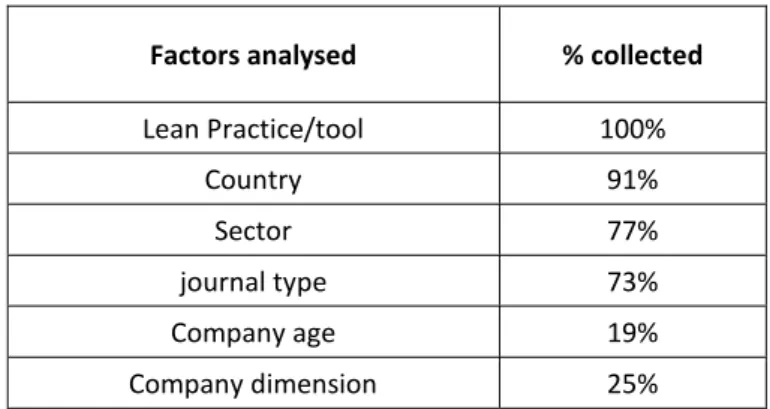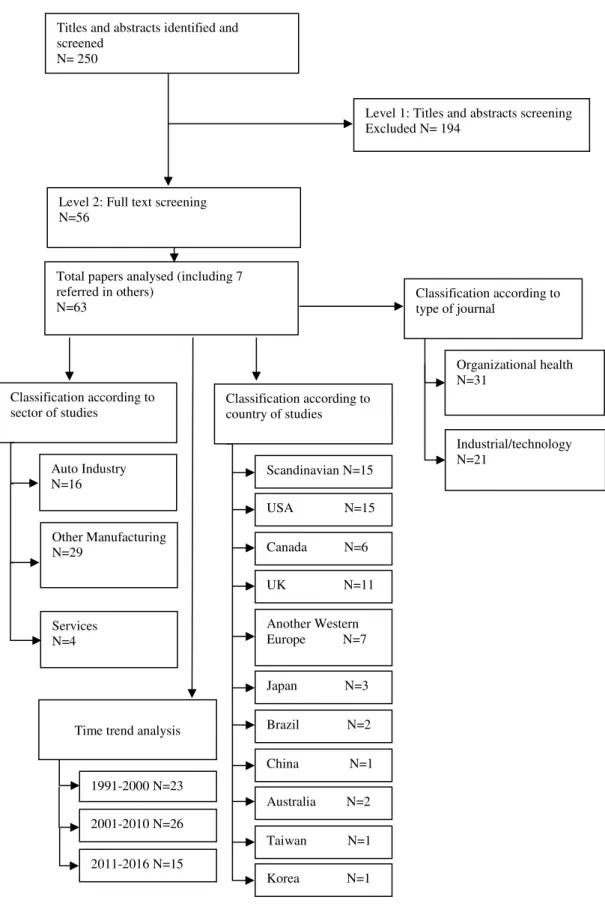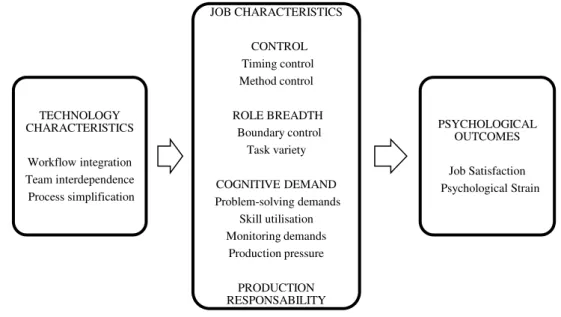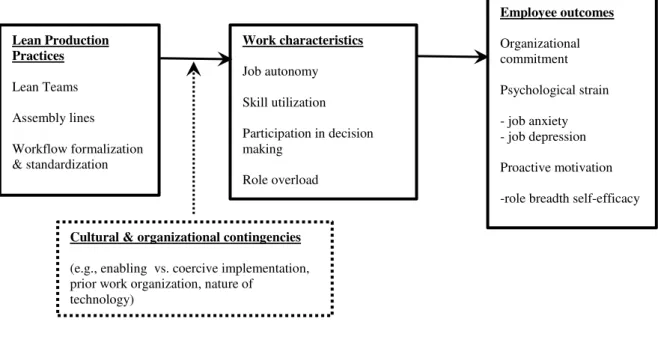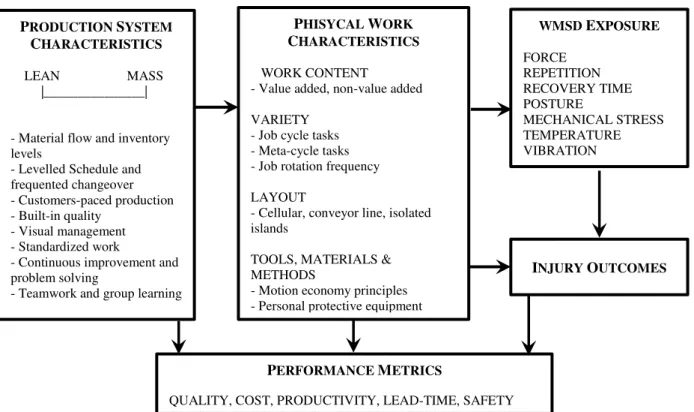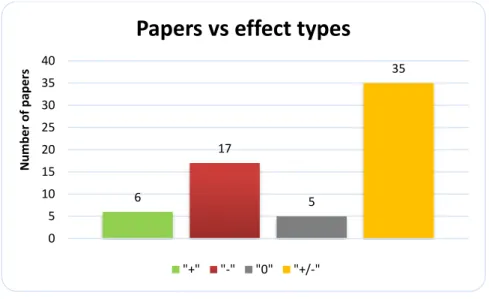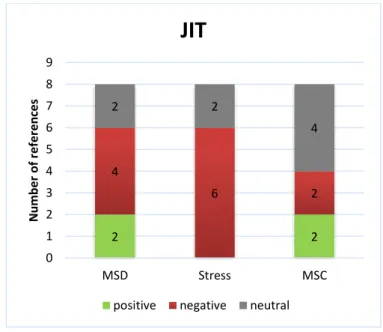José Miguel Guerreiro Gonçalves
Licenciatura em Ciências de Engenharia Civil
Beyond Lean and the Working Environment
Dissertação para obtenção do Grau de Mestre em Engenharia e Gestão Industrial
Orientadora:
Professora Doutora Helena Victorovna Guitiss Navas,
Professora Auxiliar, Faculdade de Ciências e Tecnologia da Universidade
Nova de Lisboa
Coorientador:
Doutor António Sartal Rodríguez, Investigador
Pós-Doutorado, Universidade de Vigo
Júri:
Presidente:
Prof. Doutora Isabel Nascimento Lopes Nunes
Arguente:
Prof. Auxiliar Denis Alves Coelho
Vogal:
Prof. Doutora Helena Víctorovna Guitiss Navas
Júri:
i
Beyond Lean and the Woking Environment
© 2017 José Miguel Guerreiro Gonçalves
Faculdade de Ciências e Tecnologia da Universidade Nova de Lisboa
Copyright
iii
ACKNOWLEDGMENTS
I would like to extend my deepest thanks to Professor Helena Victorovna Navas and Professor Antonio Sartal Rodríguez for their guidance, dedication, sympathy and professionalism.
v
ABSTRACT
Lean Production System (LPS) has become very popular among manufacturing industries, services and large commercial areas over the years due to its production increase abilities. However, LPS practices can have both negative and positive impacts in worker’s psychosocial factors like motivation, satisfaction and commitment and physical and psychological health factor like musculoskeletal disorders (MSD) and stress.
Since LPS is a very broad term, there is no simple relation between LPS implementation and its consequences over work environment and workers. Therefore, it is necessary to study the different factors that can affect the work environment in each case. A wide variety of LPS practices can have negative and positive impacts on workers. Furthermore, the effects of lean may also depend on the sector and country in which it is implemented. There are no studies in the literature that cover all these effects and analyse them together with the involved environment. In this study, articles were collected in scientific publications in the last 26 years and analysed.
Results show that Just-in-Time (JIT) practices are strongly related with negative effects in MSDs and stress caused by intensification of work and increase of control over workers. However, JIT practices such as manufacturing cells can increase job enrichment trough multi-skilling.
Respect for people practices can act as buffers to lean practices. Job rotation reduces human effort and work pace trough the increase of recovery time. Workgroups create job support acting as buffers to psychosocial factors. Results show a majority of negative effects in the automotive sector and in countries such as Canada, USA and UK. Scandinavian countries have implemented hybrid forms of Lean which are related to an increase in effects such as motivation and job satisfaction. However, the overall analysis is that the effects of lean on workers depend more on the way companies manage and implement it rather than the countries cultural factors.
This study can be useful for managers and leaders who seek to transform traditional enterprises into exemplars of lean success, showing the need to balance lean and good working conditions.
vii
RESUMO
O Lean Production System (LPS) tornou-se muito popular entre as indústrias de produção, os serviços e as grandes áreas comerciais ao longo dos anos, devido às suas potencialidades de aumento de produção. No entanto, as práticas de LPS podem ter impactos negativos e positivos nos fatores psicossociais dos trabalhadores, nomeadamente na motivação, satisfação e empenho, e nos fatores de saúde física e psicológica, nomeadamente nas lesões músculo-esqueléticas e no stress.
Como o LPS é um termo muito abrangente, não existe uma relação simples entre a sua implementação e as consequências no ambiente de trabalho e trabalhadores. Portanto, é necessário estudar os diferentes fatores que podem afetar cada caso. Uma grande variedade de práticas do LPS pode ter impactos negativos e positivos sobre os trabalhadores. Além disso, os efeitos do LPS também podem depender do setor e país em que é implementado. Não existem estudos na literatura que cubram todos estes efeitos e os analisem em conjunto com o meio envolvente. Neste estudo, os artigos analisados foram recolhidos em publicações científicas dos últimos 26 anos.
Os resultados mostram que as práticas Just-in-Time (JIT) estão fortemente relacionadas com efeitos negativos nas lesões músculo-esqueléticas e no stress causado pela intensificação do trabalho e aumento do controlo sobre os trabalhadores. No entanto, as práticas do JIT, como as células de produção em U, podem aumentar o enriquecimento do trabalho através da multivalência.
O respeito pelas pessoas pode aliviar os efeitos negativos das práticas do Lean. A rotatividade do trabalho reduz o esforço humano e o ritmo através do aumento do tempo de recuperação. O trabalho em equipa cria suporte, contribuindo para aliviar efeitos psicossociais como motivação e satisfação. A maioria das referências a efeitos negativos foi encontrado no setor automóvel e em países como o Canadá, EUA e Reino Unido. Os países escandinavos implementaram formas híbridas do Lean que estão relacionadas com um aumento de efeitos positivos, como motivação e satisfação no trabalho. No entanto, a análise geral é que os efeitos do Lean sobre os trabalhadores dependem mais do modo como as empresas o gerem e implementam, do que dos fatores culturais dos países.
Este estudo poderá ser útil para gestores e líderes que procuram transformar as empresas tradicionais em exemplos de sucesso do Lean, mostrando que é necessário equilibrar o Lean e as boas condições de trabalho.
ix
Contents
1 Introduction ... 1
1.1 Background and study objectives ... 1
1.2 Outline ... 2
2 Lean Philosophy ... 5
2.1 Main Lean practices and tools ... 9
2.1.1 Just-In-Time ... 9
2.1.2 Jidoka ... 11
2.1.3 Respect for People ... 15
3 Musculoskeletal disorders, stress and psychosocial health effects description ... 18
3.1 Musculoskeletal disorders ... 18
3.2 Stress ... 19
3.3 Psychosocial health ... 21
4 Study methodology ... 23
4.1 Research design ... 23
5 Effects of lean production on workers and hypotheses presentation ... 27
6 Interaction models between lean practices and effects on workers ... 31
6.1 Jackson & Martin Model ... 31
6.2 Parker Model ... 33
6.3 Womack Model ... 34
7 Bibliographic analysis results and discussion ... 35
7.1 Lean practices Vs MSD/Stress/MSC ... 36
7.1.1 JIT Vs MSD/Stress/MSC ... 36
7.1.2 Jidoka Vs MSD/Stress/MSC ... 38
7.1.3 JIT and Jidoka Vs MSD/Stress/MSC ... 39
7.1.4 JIT, Jidoka and RfP Vs MSD/Stress/MSC ... 40
7.2 Sector Vs MSD/Stress/MSC ... 41
7.3 Country Vs MSD/Stress/MSC ... 45
7.4 Journal type Vs MSD/Stress/MSC ... 50
7.5 Time trend Vs MSD/Stress/MSC ... 51
8 Proposed interaction model between lean practices and effects on workers ... 57
9 Conclusions ... 59
Bibliography ... 61
xi
Figure Index
Figure 2.1-Toyota Production System House ... 8
Figure 2.2- U-shaped production line layout ... 10
Figure 2.3- Example of 5 why's technique ... 13
Figure 3.1-Job demands-control model ... 21
Figure 4.1-Literature review flowchart ... 25
Figure 6.1-Jackson & Martin model ... 31
Figure 6.2-Parker model ... 33
Figure 6.3- Womack model ... 34
Figure 7.1-Number of papers according to effects’ type in literature review ... 35
Figure 7.2-Effects’ references accorging to JIT practices in literature review ... 36
Figure 7.3-Effects’ references accorging to Jidoka practices in literature review ... 38
Figure 7.4-Effects’ references accorging to JIT+ Jidoka practices in literature review ... 39
Figure 7.5-Effects’ references accorging to JIT+Jidoka+RfP practices in literature review ... 40
Figure 7.6-Overall effects’ references on workers in literature review according to Sector ... 42
Figure 7.7-Effects’ references on MSD in literature review according to Sector ... 43
Figure 7.8-Effects’ references on Stress in literature review according to Sector ... 43
Figure 7.9-Effects’ references on MSC in literature review according to Sector... 44
Figure 7.10-Combined effects in literature review according to Country ... 46
Figure 7.11-Effects on MSD in literature review according to Country ... 47
Figure 7.12-Effects’ references on Stress in literature review according to Country ... 47
Figure 7.13-Effects on MSC in literature review according to Country ... 48
Figure 7.14-Effects in literature review according to Organizational Health journal type ... 50
Figure 7.15-Effects in literature review according to Industrial journal type ... 50
Figure 7.16-Trend analysis on lean effects literature ... 51
Figure 7.17-Effects on MSD in literature review according to article’s publication year ... 52
Figure 7.18-Effects on Stress in literature review according to article’s publication year ... 52
Figure 7.19-Effects on MSC in literature review according to article’s publication year ... 53
Figure 7.20- Studied sectors trend ... 53
xiii
Table Index
xv
Acronyms
IMVP - International Motor Vehicle Program
JIT - Just-In-Time
MSC - Motivation, Satisfaction and Commitment
MSD - Musculoskeletal Disorders
QC - Quality Circles
QCC - Quality Control Circles
RfP - Respect for People
TPM - Total Preventive Maintenance
TPS - Toyota Production System
TQM - Total Quality Management
UK - United Kingdom
USA - United States of America
1
1
Introduction
With this chapter, it is intended to introduce the work’s development. Firstly, is presented the theme context and the objectives to be achieved. The following is the methodology presentation and lastly, is presented the dissertation structure overview.
1.1
Background and study objectives
Lean Production is nowadays the main waste free concept applied in manufacturing industries and it is now spreading to many sectors beyond manufacturing worldwide. Lean Production was born in Japan, more specifically in the Toyota company in the 1970’s and was founded on a belief that the key to improving profit was to reduce cost (Ohno, 1988). However, its practices like “Just-in-Time” and “zero defects” can be very stressful for workers and have negative impacts like demotivation and physical and psychological health problems.
There are many studies of lean production found in literature, first in the automotive industry in the 1990s (Adler et al., 1997; Babson, 1993; Berggren et al., 1991; Lewchuck & Robertson, 1996). In more recent years, authors focused their studies on lean effects in other manufacturing sectors and services sector (Conti et al., 2006; Jackson & Mullarkey, 2000; Sprigg & Jackson, 2006). Most authors reported that in the automotive industry, lean is mainly bad for workers due to specific lean practices which were correlated with stress and musculoskeletal disorders. They also reported that in other sectors than automotive, this negative effect of lean can be also found where lean is not fully implemented. Existing studies in the literature show contradictory opinions regarding the effects of Lean on workers.
SinceLean is a very broad term, there is no unidirectional relation between lean implementation and its consequences in the work environment and the worker, that is why it is important to study the different factors that affect each case.
2
technological intensity, and the type of journal where papers were published are also control variables in this study to find a multi-directional relation between lean production and its effects on workers. Finally, an interaction model of effects of lean production on job characteristics and their relation to MSD, stress and MSC is proposed.
1.2
Outline
The structure of this dissertation is divided in 7 different chapters, from the “Introduction” to the “Conclusions”.
1. Introduction 2. Lean Philosophy
3. Physical and psychological health effects description 4. Study Methodology
5. Effects of Lean production on workers and hypotheses presentation 6. Interaction models between lean practices and effects on workers 7. Bibliographic analysis results and discussion
8. Proposed Interaction model between lean practices and the effects on workers 9. Conclusions
In this first chapter, an introduction is done to the addressed subject, as well as the motivation of the work and its objectives. A brief description of each chapter of the dissertation is also presented.
In chapter 2 the theoretical concepts of Lean Philosophy are covered. The philosophy is described and the fundamental principles reviewed. The main practices intrinsic to Lean are specified with focus on the three pillars of Lean which are Just-in-Time, Jidoka and Respect for People.
In chapter 3, the theoretical concepts of physical and psychological health effects are covered. It describes physical health effects, namely musculoskeletal disorders. Also, psychological health effects like stress, motivation, satisfaction and commitment, are described in this chapter.
Chapter 4 addresses the study methodology, bibliographic research and screening.
3
In chapter 6, interaction models between lean practices and effects on workers found in literature are presented and described.
In chapter 7, bibliographic results are analysed and discussed trough diagrams showing the effects of lean on workers, positive negative or mixed. In the sub-chapters, different combinations of control variables like the sector where lean is implemented and the country are analysed to better understand these effects.
In chapter 8, an interaction model between lean and the effects on workers is proposed, based on the results found in chapter 7.
5
2
Lean Philosophy
The term Lean Production was used by Krafcik in 1988 to nominate the production organisation system used in some Japanese automotive plants installed in the U.S. during the 1980’s (Holweg, 2007). This system, called Toyota Production System (TPS) was developed in Toyota automotive plants after the World War II by the Vice-President of Toyota Motor Company, Mr. Taiichi Ohno and became known since the first oil crisis in 1973. Despite the crisis, Toyota results were extraordinary, generating curiosity in other plants. Their ability in designing and building cars in less time, with less people and lower inventories was remarkable (Arezes et al., 2014).
About TPS concept, it’s stands point was in recognizing of Japan’s distinguishing features (Sugimori et al., 1977). The most distinctive feature of Japan is the lack of natural resources, which makes it necessary to import vast amounts of materials including food. Japan is placed under a disadvantageous condition in terms of cost of raw material when compared to the European and American countries. To overcome this handicap, it is essential to put forth the best efforts to produce better quality goods having higher added value and at an even lower production cost than in the other countries. This was the first thing that Toyota recognized.
6
5 Principles of Lean Thinking
According to Futata (2005), the TPS main goal is to eliminate any activity or resource that does not add value to the final product, ending with waste this way. Lean production’s paradigm evolved in to a thinking paradigm, Lean Thinking, which focuses in improving productivity, efficiency and quality of the products or services using the least quantity of resources as possible. According to Womack & Jones (1996), there are 5 principles of Lean Thinking:
Value- Specification of the value of a particular product that the costumer really needs;
Value stream- Identification and analysis of the value flow for each product;
Continuous flow- Establishing a continuous value flow, characterized by the ability to produce just the necessary for the moment;
Pull- Let the costumer “pull” the product, trough the implementation of Pull system allowing to produce
only when the costumer order is made, producing just the necessary when necessary;
Perfection- Seeks perfection and innovation trough continuous improvement.
A Lean organization understands what constitutes value to the customer, being that, from this definition, it focusses in the key processes to increase it. The final objective will be the creation of a perfect process of value creation to the costumer, seeking its continuous improvement (Womack et al., 1990).
7 Major Kinds of Waste
Continuous improvement focuses on the elimination of 7 major types of waste (Shingo & Dillon, 1989; Suzaki, 1987; Art of Lean Inc., 2017):
7
Over-production- There are two types of overproduction, producing too much and producing too early. Examples of waste caused by overproduction are: necessity for extra material and parts; increase in containers such as pallets and skids; increase in conveyance vehicles; the growth of stock and increase in labor.hours for stock control and increase in storage and warehouse space. The principal factors that causes overproduction are: a sense of security against machine breakdown, defects and absenteeism.
Waiting-idle time- Time is a limited resource. Any waiting due to breakdowns, changeovers, delays, poor layout or work sequence needs to be eliminated. Reducing cycle time by eliminating waiting within the work sequence can have a profound effect in productivity.
Processing - redundant or inefficient steps in the process. Employees must learn to identify over processing waste, and perform the appropriate amount of processing on parts without spending more time or effort than is necessary.
Inventory- parts waiting in process or in finished goods storage. The smooth, continuous flow of work through each process ensures that excess amounts of inventory are minimized. If work-in-process develops because of unequal capabilities within the process, efforts need to be made to balance the flow of work through the system. Inventories often require additional handling which requires additional labour and equipment.
Motion- Wasted motion occupies time and energy. Much of the wasted motion is often overlooked because it has become such a part of the process. Work processes should be designed so that items are positioned close to each other. Unnecessary amounts of turning, lifting and reaching are eliminated. The same improvements that eliminate wasted motion often have ergonomic benefits as well.
Conveyance - Inefficient layouts and facility design results in conveying parts, materials and people more than is necessary. Material should progress from one cell or position to the next as quickly as possible without stopping at any intermediate storage place. Shipping areas should be close to the end of the process. Work teams and support units should be located close together.
TPS Fundamental Pillars
8
improvement philosophy more known as Kaizen (Ohno, 1988; Liker 2004), see Fig.2.1, as adapted from Liker (2004) for the TPS house.
Although these two pillars appear in most of the literature regarding Lean Manufacturing, there is little literature referring the heart of the TPS house, being that the Respect for People (Emiliani, 2008). Toyota is convinced that the company goals can be reached in the best way through participation of all employees. A major part of the production system is the underlying concept of respect for all employee (Art of Lean Inc., 2017). Also, TPS identifies the four main areas where the production team members can participate in achieving company goals (Art of Lean Inc., 2017):
➢ Standards - setting and maintaining work standards;
➢ Problem solving - solving daily performance problems;
➢ Improvement - participating in the continuous improvement process;
➢ Teamwork - organizing teamwork efficiently.
Figure 2.1-Toyota Production System House (Adapted from Liker, 2004)
Goal: Highest Quality, Lowest Cost, Shortest Lead Time
Just-in-Time Jidoka
Continuous flow
Takt Time
Pull Sustem
Stop and notify of abnormalities
Separate man’s Work & machine’s
work
Heijunka Standardized Work Kaizen
Stability
9
2.1
Main Lean practices and tools
This sub-chapter describes the most common Lean practices and tools found in each of the Toyota Production System House pillars as shown in Figure 2.1.
2.1.1
Just-In-Time
When first developed in Japan in the 1970s, the idea of the Just-in-Time (JIT) advocated: producing and/or delivering only the necessary parts, within the necessary time in the necessary quantity using the minimum necessary resources. This is called a Pull System. A typical vending machine is a good example of a pull system in action. The customer ‘pulls’ the items needed, in the quantity needed, at the time needed. The supplier replaces (fills up) only those items ‘pulled’ by the customer (Art of Lean Inc., 2017). The old system became known, by contrast, as just-in-case or Push System. Inventory was held for every possible eventuality, just in case it came about.
JIT eliminated buffer stocks for each stage in the production process, resulting in remarkable savings. This production philosophy also increased workforce involvement in controlling their own inventory needs and allowed a variety of products to be produced on the same assembly line simultaneously. Before JIT, assembly lines had been able to produce only one type of product at a time, in a way that, to produce another type of product the production line was required to stop and the retooling was expensive.
JIT characteristics: There are three characteristics that define the nature of JIT systems: increased workflow integration, pooled interdependency, and process simplification, (Jackson & Martin,1996):
Workflow integration: A key defining characteristic of JIT is the removal of barriers between stages in the production process so that work flows directly from one stage to the next without the buffering of in-progress inventory. This feature of technological systems has been described as workflow integration (Jackson & Martin,1996).
10
Process simplification: The third key feature of JIT is the simplification of work procedures and production schedules to remove blockages to the free flow of production (Jackson & Martin,1996).
U-shaped production line
The U-shaped production line is described as the special type of cellular manufacturing used in JIT production systems. The U-line arranges machines around a U-shaped line in the order in which
production operations are performed. Operators work inside the U-line. One operator supervises both the entrance and the exit of the line. Machine-work is separated from operator-work so that machines
work independently as much as possible. Standard operation charts specify exactly how all work is done. U-lines may be simple or complex. U-lines are rebalanced periodically when production requirements
change. The U-line satisfies the flow manufacturing principle. This requires operators to be multi-skilled to operate several different machines or processes. It also requires operators to work standing up and walking. When setup times are negligible, U-lines are operated as mixed-model lines where each station
can produce any product in any cycle. When setup times are larger, multiple U-lines are formed and dedicated to different products. The average U-line has 10 machines and 3 operators (Miltenburg, 2001). Figure 2.2 illustrates a U-shaped production line layout.
Figure 2.2- U-shaped production line layout (Miltenburg, 2001)
Kanban
One of the most used tools in the JIT system is the Kanban, which means card in Japanese. This card is sent to reorder a standard quantity of parts when they have been used up in the manufacturing process. Before JIT, batches of X + Y parts were ordered at a time, and the Kanban would be sent for a replacement order when only Y parts were left. With JIT, only Y parts were ordered, and the Kanban
11 Takt Time
Another indispensable tool in a JIT system is the Takt Time. It aims at eliminating over-production, the greatest of the seven wastes. “Takt” is the German word for rate and it is the principle that all activity
within a business is synchronized by a pulse, set by the customer demand. Takt time is calculated dividing the production time available by the customer demand. For example, if the demand is 100 products per day and the time available for production is 450 minutes per day, the calculated takt time would be 4,5 minutes. Cycle Time is the time required for the execution of a part, or the time elapsed between the repetition from start to end of operation. This two metrics should always be compared to have a smooth production flow and the right quantity of products in inventory.
Value Stream Mapping (VSM)
One of the essential tools for achieving the goals outlined by Lean Production is the Value Stream Mapping (VSM) and its main objective is to diagnose the value flow in an organization. Through this diagnosis, it is possible to verify the existence of waste, being later adopted measures for its disposal. The study is carried out on a product, from the form of raw material up to the finished product, identifying the relationship between the material flow and the information flow over the entire production (Rother & Shook, 2009). Ohno (1988), defends the importance of the quantitative data represented in the VSM, since it will be from the values collected that decisions will be taken to improve the value flow.
2.1.2
Jidoka
Jidoka is a Japanese term used in the TPS that can be defined as “automation with a human touch”. The
term Jidoka first appeared with the invention of the automatic loom by Sakichi Toyoda, the Founder of the Toyota Group. This loom had some devices incorporated that allowed the machine to stop when a defect was detected. Also, later Sakichi invented the world’s first automatic loom, with non-stop shuttle- change motion, which could detect defects and correct them without stopping operation. This built-in device applied in machines for making judgments are referred by Toyota as “jido”. This production
12
Jidoka frees people being tied to machines and monitoring them and puts people to use in a more value-added fashion. This ability to separate man from machine reflects Toyota’s respect for the employee and is an important enabler for Standardized Work to flourish (Art of Lean Inc., 2017).
Total Quality Management
Some of Jidoka’s tools are part of Total Quality Management (TQM). TQM is “The management of
quality at every stage of operations, from planning and design trough self-inspection, to continual process monitoring for improvement opportunities” (Radnor, 2000). Also, other authors referred that “TQM is a corporate culture characterized by increased customer satisfaction trough continuous improvement, in which all employees in the companies participate actively” (Boaden, 1997). One of the most popular concepts used in quality control is zero defects. “Zero Defects is a management tool aimed at the reduction of defects through prevention. It is directed at motivating people to prevent mistakes by developing a constant, conscious desire to do their job right the first time” (Halpin et al., 1966). Activities such as improvement, statistical control, supply control and quality engineering are ingredients of TQM.
Building in Quality, means that each team member of a work chain, must be aware that the downstream process is a costumer and must never pass on a defective product. If something abnormal happens, the operation must be stopped.
Andon Boards
An important tool for “visual control” or “problem visualization” is the Andon boards. These boards consist in displaying boards that show when an equipment stops due to a problem, allowing operators to identify problems in the production line with only a glance.
Poka-Yoke
Another way to improve quality in the production process is trough utilization of defect-proof tools, called Poka-yoke. This tool when installed in a machine or workstation prevents mistakes, in other words, even if you want to do wrong, poka-yoke does not allow it.
Standardized Work
13
Many documents exist to guide operators, define processes, document standard methods, and train team members. Two common documents posted in the production area are the Standardized Work Chart and Quality Check Sheets.
The Standardized Work Chart is a document, centred around repetitive human movement, that combines the elements of a job into an effective work sequence, without waste. It also serves as a visual control tool for leaders and managers to easily determine if there is a problem in the work area.
Quality check sheets define the quality checks that must be performed by team members in the work area. It provides instruction on which characteristics are to be checked, the required specifications to be met, what inspection method is used, where data is recorded, the frequency of the quality check, and what the inspector must do if there is a problem (Art of Lean Inc., 2017).
5 Whys Technique
Productivity can be increased trough measures that prevent the occurrence of anomalous situations. Once an anomaly is detected, it is necessary to go deep into the root cause to solve it at once and avoid recurrence. With Jidoka, an equipment stops whenever an anomaly is detected. In this occasion, it is necessary to analyse carefully the reason the equipment stopped, acting swiftly in eradicating the anomaly and avoiding its occurrence again.
A powerful tool that aims at finding the root cause of a problem is the 5 whys technique. It consists at asking 5 times why a problem occurred. Figure 2.3 shows an example of a 5 whys technique.
Figure 2.3- Example of 5 whys technique
Therefore, questioning the answers with successive whys, the root cause of a problem can be found, corrected and procedures can be standardized. Workers must be conditioned to question every situation. Not only the occurrences of anomalies, but also the situations in which successes are obtained, questioning “why did it work?”.
The switch is released
Why the switch come
loosed?
No application of lubricant
Why was not lubricant applied?
14 Total Preventive Maintenance
Another practice is the Total Preventive Maintenance (TPM), which consists in a highly organised program of periodic machine maintenance and pre-emptive replacement of components such as bearings to minimise the frequency and duration of machine break-downs. Routine minor maintenance during work hours is done by workers. This practice avoids major maintenance problems with associated production losses and costs.
Kaizen
Taiichi Ohno, the founder of TPS, once said "If a problem is left unsolved and the supervisor in uninformed, neither kaizen nor cost reduction can be applied. When there is trouble, stopping the machine means also identifying the problem. Once the problem is clear, kaizen becomes possible" (Ohno, 1988).
Kaizen is a concept that focuses on continuous improvement of all levels of company and involves all. Everyone is encouraged to come up with small improvement suggestions on a regular basis. This is not a once a month or once a year activity. It is continuous (Liker, 2004). Japanese managers have generally decided that at least 50 % of their time should be spent at activities which are related to improving and developing” (Imai, 1986). In a visit at the Toyota assembly plant in the Unites States of America, it was found that the employees handed over 80 thousand improvement proposals within one year. Total of 99 percent of them were implemented in the plant (Liker, 2004). It is necessary to recognize the need for improvement to improve. Problem recognition is necessary. If no problem is recognized, there is no recognition of the need for improvement. “Complacency is the arch-enemy of Kaizen. Therefore, Kaizen
emphasizes problem awareness and provides clues for identifying problems” (Imai, 1986).
Quality Control Circles
15
storming, pareto diagrams, Ishikawa diagram, cause & effect analysis, data collection and data analysis (Welekar, 2013).
5S
Another powerful tool is 5S, a five-step housekeeping discipline that includes methods for creating and maintaining an organized, clean, high performance workplace (Art of Lean Inc., 2017). The philosophy of the 5S has its roots in Japan. The name 5S is the acronym of five Japanese words of the following meanings: Seiri (Sort); Seiton (Set in order); Seiso (Shine), Seiketsu (Standardize), Shitsuke (Sustain). The benefits of a good workplace include the prevention of defects, prevention of accidents and the elimination of time wasted for searching tools, documentation and other ingredients of manufacture (Wazed & Ahmed 2009). Its result is the effective organization of the workplace, elimination of losses connected with failures and breakdowns in machines, improvement of the quality and safety of work.
2.1.3
Respect for People
Lean is not just tools, it is also respect for people. Lean community leaders have recently made two huge changes in how they present Lean. The first change is Lean as a management system rather than “Lean manufacturing”. Second, they are finally taking note of the long-established “Respect for People” principle (Emiliani, 2008). Toyota’s top-level representation of the “Respect for People” principle consists of two parts: “Respect” and “Teamwork”, and is as follows (Liker, 2004):
“Respect: We respect others, make every effort to understand each other, take responsibility and do our best to build mutual trust.
Teamwork: We stimulate personal and professional growth, share the opportunities of development and maximize individual and team performance.”
The “Respect for People” principle encompasses all key stakeholders: employees, suppliers, customers, investors and communities (Liker, 2004). This principle is a multilateral expression of the need for balanced, mutually respectful relationships, cooperation and co-prosperity with all these stakeholders. This is why this principle is anything but trivial to understand (Emiliani, 2008).
16
Participation can be exercised primarily in areas where the employee or the work team has sufficient knowledge, or in other words, is competent. TPS identifies four areas where team members can participate in achieving company goals (Art of Lean Inc, 2017):
➢ Setting and maintaining work standards (standards);
➢ solving daily performance problems (problem solving);
➢ participating in the continuous improvement process (improvement);
➢ organizing teamwork efficiently (teamwork).
Continuous improvement recognizes the creativity and problem-solving ability of all participants. Leadership must make every attempt to utilize the knowledge, experience and creativity of all employees. This shows respect for the individuals’ dignity and worth. Creating an environment of mutual respect, trust, and cooperation is critical for making improvements and maintaining morale.
In the Toyota culture, it is impossible to achieve quality, cost and productivity improvements without consideration for safety and morale. Issues that affect individuals are critically important and must be addressed continuously.
Improving workplace safety is an ongoing topic for continuous improvement. Statistics show a high incidence of accidents occur when an individual is doing something out of the ordinary, the area is unorganized, or when tasks are difficult to perform. Reducing workplace hazards shows respect for people. Every effort should be made to make the workplace as safe as possible. Safety should never be sacrificed in the name of productivity. For this reason, Toyota places a lot of emphasis on standardized work and 5S housekeeping. If proper standards are in place, and adhered to, then the probability for a safe work environment is greatly enhanced (Art of Lean Inc, 2017).
Respect for workers can be conceptualized as the glue that holds the other lean tools and practices together and according to De Treville (2006), the objectives of respect for employees are to reduce alienation through expressing respect, recognition and appreciation and making the job more interesting, thereby reducing variability, as well as to make maximum use of worker knowledge, thereby increasing resource utilization and reducing the need to hold buffer inventories.
17
territory, where members rotate from job to job with some regularity, under a flexible allocation of tasks” (Mueller, 1994). Normally, this teams work in a U-shaped cell layout with all machines necessary to produce a product or a family of products (Hyer, 2001). U-shaped layout is preferred because it contributes to less monotony in terms of work (Miltenburg, 2001; Zhenyuan, 2011). Working on this cell arrangement, the team members can adopt different and flexible work patterns or cell operating modes. According to Cialdini and Goldstein, work teams has been observed in lean to be a source of both support and stress. Support, in that team members help each other, and stress, in that team norms can induce (Cialdini & Goldstein, 2004).
18
3
Musculoskeletal disorders, stress and psychosocial
health effects description
In this chapter, the aimed studied effects of Lean on workers are described. Musculoskeletal disorders are described in chapter 3.1, stress is described in chapter 3.2 and psychosocial effects including job satisfaction, commitment and motivation, are described in chapter 3.3.
3.1
Musculoskeletal disorders
Work-related musculoskeletal disorders (MSDs) cover a broad range of health problems associated with repetitive and strenuous work. These health problems range from discomfort, minor aches and pains, to more serious medical conditions which can lead to permanent disability. Every year millions of European workers are affected by MSDs. The most well-known MSDs are low back pain and work-related upper limb disorders. The first is mainly associated with manual handling while the main risk factors for the latter are associated with task repetition and awkward work postures. Nowadays lower limb work-related MSDs are also been recognized as disorders that may be associated with occupational activity (Nunes, 2017).The term work-related MSDs refers to health problems affecting the muscles, tendons, ligaments, cartilage, the vascular system, nerves or other soft tissues and joints of the musculoskeletal system. They are caused or aggravated primarily by work itself and they can affect the upper limb extremities, the neck and shoulders, the lower back area, and the lower limbs (Nunes, 2017).
Although automation systems have been introduced and reduction of intensive work has been achieved with the help of ergonomic interventions in the last decades, there is an increasing trend towards more musculoskeletal disorders (Koukoulaki, 2014). According to data from the Sixth European Working Conditions Survey, conducted in 35 countries, about 75-80 million workers, almost half of European workers, suffer from work-related MSDs. 44.7% of the workers reported backache and 44.4% muscular pains in shoulders, neck and/or upper/lower limbs (Nunes, 2017).
19
country itself. In general, the cost to the EU each year in lost productivity and sickness absences is estimated at 2% of the gross domestic product (Nunes, 2017).
Findings suggest that the impact on the prevalence of MSDs is not related to the industry sector but to the actual content of the job. When controlling for the actual content of the job, no significant differences emerge among industries (Nunes, 2017).
The strong correlation between the incidence of MSDs and working conditions is well known, particularly considering the physical risk factors associated with jobs (e.g., awkward postures, high repetition, force exertion, static work, cold or vibration. Work intensification, stress and other psychosocial factors also seem to be factors that increasingly contribute to the onset of those disorders (Nunes, 2017).
The causes of work-related MSDs are multifactorial and there are numerous work-related risk factors for the various types of MSDs. Several risk factors including physical and mechanical factors, organisational and psychosocial factors, and individual and personal factors may contribute to the genesis of MSDs (Nunes, 2017).
Work-related MSDs refer to injuries developed over time that are caused by a combination of risk factors that act simultaneously on a joint or body region, in a synergistic effect. Until now the biological pathogenesis associated with the development of the majority of the work-related MSDs is unknown. Several models have been proposed to explain the biological mechanisms. Usually three sets of factors are considered (Nunes, 2017):
• Physical factors (e.g., sustained or awkward postures, repetition of the same movements, forceful exertions, hand-arm vibration, all-body vibration, mechanical compression, and cold);
• Psychosocial factors (e.g., work pace, autonomy, monotony, work/rest cycle, task demands, social support from colleagues and management and job uncertainty);
• Individual factors (e.g., age, gender, professional activities, sport activities, domestic activities, recreational activities, alcohol/tobacco consumption and, previous work-related MSDs).
3.2
Stress
20
ingredient in developing and sustaining a psychologically healthy work environment. However, excessive and prolonged pressure and demands that exceed the worker’s perceived resources, capabilities and skills to cope should not be understood as a ‘healthy pressure’ or ‘good stress’, but rather as the defining components of work-related stress (Hassard & Cox, 2017).
Poole & Warner (1998) describes the prevailing view: “It (stress) is widely viewed today as the
physiological and psychological reaction which occurs when individuals meet a threat or challenge and the individuals’ perception, whether consciously or subconsciously, is that it is beyond their immediate capacity”. Repeated exposure to this condition can result in strains that cause physical reactions (such as insomnia), emotional reactions (such as depression), and mental reactions (such as forgetfulness).
Contemporary theories of stress have been used to inform the definition of work-related stress. There is a growing consensus around the definition of stress as a negative psychological state with cognitive and emotional components, and its effect on the health of both the individual and the organisation. That is, stress is defined by a dynamic interaction between the individual and their environment, and is often inferred by the existence of a problematic person-environment fit and the emotional reactions which underpin those interactions. Central to this approach is the role that environmental factors, particularly the role of psychosocial and organisational factors, play in work stress (Hassard & Cox, 2017). Examples of psychosocial risks are low job control, job demands, time pressure, social relations with superiors and colleagues and job insecurity, which are all related to work-related stress, violence and bullying (Leka et al., 2003).
The 4th European Working Condition Survey found that 22% of workers from 25 Member States and two Acceding Countries of the EU reported experiencing stress in the workplace. The reported prevalence of stress is markedly different between the new Member states and the old EU-15. Results from the 4th European Working Conditions Survey showed that 20% of workers from the EU-15 and 30% of the 10 new Member states believed their health was at risk due to stress at work (Hassard & Cox, 2017).
21
In the UK, an estimated 70 million working days are lost annually through poor mental health and 10 million of these are the result of anxiety, depression and stress. In 2005/06 stress, depression and anxiety was estimated to cost Great Britain in excess of £530 million. Undoubtedly, the causes and effects of work stress reflect the changing nature and demands of work and the work environment (Hassard & Cox, 2017).
However, researchers have reported the effects of buffers in high demand environments. Dalgard et al. (2009) tested the Karasek’s (1979) demand-control model of occupational stress and reported a strong ‘buffering effect’ for the interaction between demands and control. There was almost no increase in psychological distress when high job demands were combined with high control. Figure 3.2 illustrates Karasek’s job demands-control model.
3.3
Psychosocial health
Job Satisfaction is related to task characteristics like monotony, type of work, control over job, and work methods. Repetitive tasks and monotony of work may be a cause of dissatisfaction for workers. Workers who don’t have the necessary skills to effectively perform certain tasks can also cause job dissatisfaction (Kauppinen et al. 1983).
Commitment is the attitude of the worker towards an organization which predicts the degree of involvement of the worker in their organization (Harrison et.al, 1998). Commitment also includes considerable effort of the workers on behalf of an organization, belief in organizational goals and values, and desire to maintain membership in the organization (Chen et.al, 2004). A committed worker plays a significant role in the success of an organization. Commitment is found to have positive biases with motivation, job performance and job satisfaction. Workers that are committed to the organization tend to perform at higher levels and are less likely to leave their jobs (Gamble et.al, 2008).
Figure 3.2-Job demands-control model (Karasek, 1979) Job
Control
High
High
Job Demands
Low
Low
Active Jobs
High-Strain Jobs Passive Jobs
22
Motivation can be defined as “predisposition to behave in a purposeful manner to achieve specific,
unmet needs and the will to achieve, and the inner force that drives individuals to accomplish personal organizational goals” (Williams, 2012). The more motivated an employee is, the more likely they are to have organizational commitment and identify themselves with the organization. This will meet some of the unmet needs, and connect them with the organization. If willing, the manager can give the employee incentives to meet their own goals and the goals set by the organization (Burton, 2012).
23
4
Study methodology
In this study, a systematic literature review was done with the purpose of identifying the effects, positive or negative, of lean practices on people at work. It was looked for effects on MSD and ergonomic risk factors, stress and MSC. To do so, over 50 papers and dissertations published between 1991 and 2016 were reviewed, which was helpful to study the changes in the focus of investigations over this period. There are a few literature reviews aiming this subject (Koukoulaki, 2014; Brännmark & Håkansson, 2012; Arezes et al., 2014) with a wide variety of conclusions, but since Lean is a very broad term, there are no simple relations between its implementation and consequences in work environment. This study tries to go beyond the studies already done by including several control variables aiming to better understand which ones have more impact on workers’ effects.
4.1
Research design
The research was made using the databases Business Source Premier and Web of Knowledge. In the research, there were two group terms (dependent variable and independents variables). The first one to identify Lean (here we use only two search items: Lean and JIT) and the second to identify the independent variables associated with well-being (stress, job satisfaction, psychosocial, health, disease, well-being or wellbeing, working conditions, injuries).
The inclusion criteria for the search were:
➢ Papers published in English from 1992-2017 (June);
➢ Studies published in peer-reviewed scientific journals;
➢ Studies carried out in manufacturing sectors and services.
The exclusion criteria were:
➢ Papers investigating only lean implementation and company productivity or similar performance effects were excluded.
Approximately 250 papers were identified in the initial search. At the first level, the papers were screened by their title and abstract and 194 were excluded. At the second level 56 papers were screened by reading full text. Some of the 56 papers referred another 7 papers which allowed collecting information from a total of 63 papers, final sample.
24
Nowadays Lean is a practice worldwide, so the countries and cultures where it is applied may affect work environment. The origin of Lean Production in the automotive sector and its application over the years in other sectors like industrial manufacture and services is a factor that may also be critic to work environment, since Lean’s development in automotive sector may not be adequate to other sectors. 91% of the papers analysed referred the country where Lean was applied and 77% referred the sector which the studied company belonged.
Company age and dimension were also chosen factors to analyse, unfortunately only 19% of the papers analysed contained this information in relation to company age and 25% in relation to company dimension, therefore excluding this factors from the study, despite the believe that these factors have a crucial impact in workers well-being.
The journal publication type was also a study factor because authors believe that, for example an ergonomics journal will focus on the negative effects of Lean, while an industrial, economics or technological journal will focus in the positive effects of Lean. Therefore, the analysed papers were grouped in Organizational Health journal’s type, including Ergonomics, Psychology, Human Factors and Labour Relations and in Industrial journal’s type, including Economy, Industrial, Production, Operations, Science and Technology. Only 73% of the papers analysed belonged to the 2 groups of journals previously described.
Table 4.1 shows the percentage of 63 papers that refers the analysed factors in the study.
Table 4.1- Percentage of papers refering the analyzed factors
Factors analysed % collected
Lean Practice/tool 100%
Country 91%
Sector 77%
journal type 73%
Company age 19%
Company dimension 25%
25
Figure 4.1 shows the systematic literature review flowchart including some of the most important factors analysed.
Figure 4.1-Literature review flowchart
Total papers analysed (including 7 referred in others)
N=63
Classification according to sector of studies
Auto Industry N=16
Other Manufacturing N=29
Services N=4
Time trend analysis
1991-2000 N=23
2001-2010 N=26
2011-2016 N=15
Classification according to country of studies
Scandinavian N=15
USA N=15
Canada N=6
UK N=11
Another Western Europe N=7
Japan N=3
Brazil N=2
China N=1
Australia N=2
Taiwan N=1
Korea N=1
Classification according to type of journal
Organizational health N=31
Industrial/technology N=21
Level 2: Full text screening N=56
Titles and abstracts identified and screened
N= 250
27
5
Effects of lean production on workers and hypotheses
presentation
In this chapter, the formulation of the study hypotheses is achieved through empirical and theoretical data found in the literature. Seven hypotheses are proposed, based on the different factors of Lean which affect the workers, and posteriorly evaluated with study results in chapter 7.
Lean pillar’s practices hypotheses
The principles of lean production are controversial from the point of view of human well-being (Antoni, 1996; Dankbaar, 1997; Delbridge, Lowe & Oliver, 2000; Jackson & Mullarkey, 2000; Kochan & Lansbury, 1997; Wall, 1996).
JIT pillar characteristics like Just-In-Time production, takt time and U-shaped production line have a common objective of maximising efficiency within the cycle time, causing work intensification and increased demands. JIT practices operates with balanced, synchronised material flow which aid in achieving this flow with minimum use of ‘wasteful’ contingencies of material, people and machinery. This improves performance but increases the intensity of work – the proportion of work time actually spent performing production tasks. Increased intensity increases job demands and the potential for job stress (Conti et al, 2006).
The Karasek model, presented in chapter 3.1, predicts that practices with high levels of physical and psychological job demands will be associated with high job stress levels. Practices that reduce these demands will accordingly be associated with lower stress levels.
The ‘Bristol Stress and Health at Work’ studies showed strong associations between perceived stress and several working conditions, including “having to work fast” (Smith, 2001). The stress of ‘working fast’ is understandable. The energy to perform a task is proportional to the work rate, determined by the required work pace and intensity (Conti & Gill, 1998). Physical job demands are greater at higher energy levels.
28
H1: Application of JIT practices alone increase stress on workers.
Job Satisfaction is related to task characteristics like monotony, type of work, control over job, and work methods as referred in chapter 3.2. Jidoka pillar practices like TQM, poka-yoke and standardization expose workers to several psychological risk factors such as low job control and effort-reward imbalance. Dierickx (2016), referred that when these practices were applied, there was a decrease in workers motivation.
Lindskog (2016) conducted a longitudinal quantitative study involving employees and managers in the healthcare service in Sweden and reported that standardized work was not considered sustainable due to the lack of job resources which ultimately reduced job satisfaction. This leads to hypothesis two as follows:
H2: Jidoka practices are negatively related to MSC effects on workers.
Respect for people pillar practices such as work teams, job support and multi-skilling. can act as buffers to the psychological effects like stress, motivation and satisfaction. Job rotation and multi-tasking act as a buffer in MSDs because it allows workers to perform different tasks which reduces repetitive work and static postures. The concept of Lean Teams implemented in many lean environments improves the working conditions for operators and stimulates satisfaction in the work (Koukoulaki, 2014). This leads to hypotheses three as follows:
H3: Respect for people practices are positively related to MSD decrease, stress reduction and MSC increase.
Company sector hypotheses
29
H4: Services sector shows better effects to MSD, stress and MSC than manufacturing sector.
Country’s culture hypotheses
Lean Production was introduced in many countries in the beginning of the 1990’s. In Sweden, Lean production started to become unfashionable towards the last years of the 1990’s decade. Companies in Sweden tried to copy the Japanese concepts, which created difficulties due to cultural differences (Seppälä & Klemola, 2004).
Some authors referred that, a common view is that Western workers will never really embrace manufacturing practices such as those involved in Lean since the Japanese work culture of commitment to the company, hard work, and group solidary are major determinants of the success of Lean in Japan. Others, refer that Japanese workers show greater commitment to their organization than workers in the West by, for example, acceptance of authority and company goals, low labour turnover, long working hours, short leave periods and high work discipline (Ouchi, 1981; Yoshida, 1989, Franke et al., 1991). This leads to hypothesis five as follows:
H5: The greater the well-being concern of the country, the greater the perception of negative effects of lean practices on workers.
Type of journal hypotheses
Nowadays, only few empirical studies of Lean Production or TPS effects on workers can be found in the scientific literature. In most cases, these point to positive effects following the introduction of Lean Production, and they have been published in engineering, logistics or economic journals. Only single empirical studies have been published from ergonomics or human science journals (Li, 2007).
Researchers sympathetic to the International Motor Vehicle Program (IMVP) are strategically placed to study management and its concerns with the impact of organisational change on productivity and competitiveness, have for the most part, ignored the impact on employees (Lewchuk et al., 2001).
30
a relationship between engineering type journals and lean positive effects on workers whereas ergonomics and psychology type of journals have a negative relation? This study is of great importance since there is none in the existing literature. This leads to hypothesis six as follows:
H6: There are positive biases related to lean practices effects on workers in industrial journals in comparison with organizational health journals.
Time trend hypotheses
Nowadays literature presents extensive studies regarding the different effects of lean production in workers focusing the MSD effects, stress and MSC. But this concerning about the different effects of lean production on workers as being evolving trough time. (Koukoulaki, 2014) studied a trend in lean production and its effects on workers trough time in his study. His analysis identifies three-time periods. The first period is after the implementation wave of lean production in automotive sector in the USA and Canada (1991-1997) in which the focus of this studies was in physical and psychological health effects like MSDs and stress. Most of the studies show negative effects. The second period (1998-2000) presents studies investigating other manufacturing sectors than the automotive mostly in Europe. The research focus started to change from MSD to psychological factors and stress. Studies’ findings show mixed effects with both positive and negative effects of different lean practices. In the last period from 2000 to present the studies were done in various sectors including the service sector that also started gradually implementing lean practices. Results show controversial both negative and mixes effects. This leads to hypothesis seven as follows:
31
6
Interaction models between lean practices and effects
on workers
This chapter presents and describes interaction models created by different authors in their studies between lean practices and the effects on workers. The models show similarities and differences. Each one of them focus on different aspects of Lean.
6.1
Jackson & Martin Model
Jackson & Martin (1996), in their study about just-in-time introduction in a batch processing environment, addressed two aims: to assess the impact of JIT on operator job content and to relate the introduction of JIT to changes in psychological outcomes. The design is strong in two respects: first, measurements were taken on two periods, before and after work design changes; and second, operators on an adjacent line not involved in the introduction of JIT were used as a comparison group.
A conceptual framework was developed based on early studies on the relationship between job characteristics and affective and behavioural outcomes. Also, technological and structural characteristics that influence choices about how jobs are design were studied as well and incorporated in the framework. Figure 6.1 shows the conceptual framework developed by Jackson & Martin (1996), for links between JIT characteristics, job content and psychological outcomes.
Figure 6.1-Jackson & Martin model (1996) TECHNOLOGY
CHARACTERISTICS
Workflow integration Team interdependence Process simplification
JOB CHARACTERISTICS
CONTROL Timing control Method control
ROLE BREADTH Boundary control
Task variety
COGNITIVE DEMAND Problem-solving demands
Skill utilisation Monitoring demands
Production pressure
PRODUCTION RESPONSABILITY
PSYCHOLOGICAL OUTCOMES
32
Each of the key components of the framework are now described:
JIT characteristics: There are three characteristics that define the nature of JIT systems: increased workflow integration, pooled interdependency, and process simplification which are described in chapter 2.1.1.
Job characteristics: The second element of the theoretical framework defines four dimensions of operator jobs that may be affected by JIT.
Operator control: The increased workflow integration associated with the removal of buffers between successive stages would be expected to redue the scope for operators to influence the timing of their work tasks. Measures of two aspects of control are utilized: control over work timing and control over work methods.
Role breadth: Role breadth encompasses two elements: the variety of tasks performed in a job, and boundary activities that support the primary operating tasks. The introduction of JIT, with its greatly enhcanced team interdependence, would be expected to lead to increases in both boundary control and task variety.
Cognitive demands: The second category of variable that is considered is that of cognitive demand in the light of suggestions that integrated manufacturing emphasizes mental rather than physical activiy. In examinng the impact of JIT on this aspect of job characteristics, two elements are considered: problem-solving demand and monitoring demand.
33
6.2
Parker Model
Parker (2003), in his study, proposed a model, shown in Figure 6.2, about the effects of lean production of work characteristics in employee outcomes. He proposed that work characteristics mediate the link between lean production practices and employee outcomes. In other words, the effects of lean production on outcomes depends, at least in part, on its effects on employees’ work characteristics. He also, hypothesised a relationship between cultural and organizational contingencies and work characteristics, but did not tested it in his study.
Figure 6.2-Parker model (2003)
To test the other relationships in the model, Parker investigated in a three-year study period a UK-based company that manufactures and assembles large vehicles. This company had introduced new initiatives to improve product quality like continuous improvement groups, and increased training. Due to the increasing demand for company products, production increased and three lean production practices were introduced: lean teams, assembly lines and workflow formalization and standardization.
The results of the study suggested negative effects on employee outcomes after the implementation of three lean production practices: lean teams, assembly lines and work standardization. Employees in all lean production groups were negatively affected, but those in assembly lines feared the worst, with reduced organizational commitment and role breadth self-efficacy and increased depression. Mediational analyses showed that the negative effects of lean production were at least partly attributable to declines in work characteristics like job autonomy, skill utilization and participation in decision making.
Cultural & organizational contingencies
(e.g., enabling vs. coercive implementation, prior work organization, nature of
technology)
Lean Production Practices
Lean Teams
Assembly lines
Workflow formalization & standardization
Work characteristics
Job autonomy
Skill utilization
Participation in decision making
Role overload
Employee outcomes
Organizational commitment
Psychological strain
- job anxiety - job depression
Proactive motivation
34
6.3
Womack Model
Womack et al. (2009), focused his study in Lean effects on physical health. His study aimed to further examine the relationship between job design and MSD risk by investigating differences in job characteristics that lend themselves to productivity and ergonomic risk differences at an exemplar lean manufacturing plant. This study was done in two companies comparing a lean manufacturing plant and a traditional manufacturing plant. In the study, authors presented a conceptual framework showed. in Figure 6.3 which shows the hypothesized links between lean manufacturing, work characteristics, injuries, and plant performance metrics.
Figure 6.3- Womack model (2009)
The exogenous “production system characteristics” construct depicts the “journey” toward becoming leaner by simplifying material flow, reducing inventory, levelling the production schedule, increasing the frequency of changeovers and producing based on customers demand (Liker, 1997). These practices have effects on how work is performed, which consequently affects MSD risk factors and injuries.
Results showed greater productivity in the lean plant, with less waiting and walking, and greater repetition exposure. Repetition was higer in the lean plant comparing to the tradicional plant. However, the lean plant had significantly lower peak hand force ratings. The findings suggested that lean manufacturing does not necessarily increase workers’ risk for MSD injuries.
PRODUCTION SYSTEM CHARACTERISTICS
LEAN MASS
|_______________|
- Material flow and inventory levels
- Levelled Schedule and frequented changeover - Customers-paced production - Built-in quality
- Visual management - Standardized work
- Continuous improvement and problem solving
- Teamwork and group learning
PHISYCAL WORK CHARACTERISTICS
WORK CONTENT
- Value added, non-value added
VARIETY - Job cycle tasks - Meta-cycle tasks - Job rotation frequency
LAYOUT
- Cellular, conveyor line, isolated islands
TOOLS, MATERIALS & METHODS
- Motion economy principles - Personal protective equipment
WMSD EXPOSURE
FORCE REPETITION RECOVERY TIME POSTURE
MECHANICAL STRESS TEMPERATURE VIBRATION
INJURY OUTCOMES
PERFORMANCE METRICS
